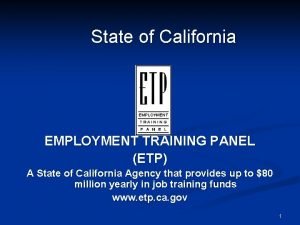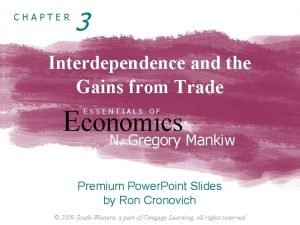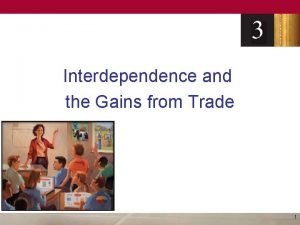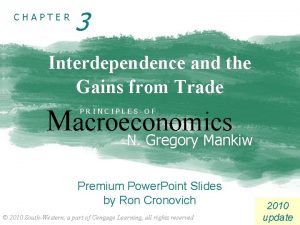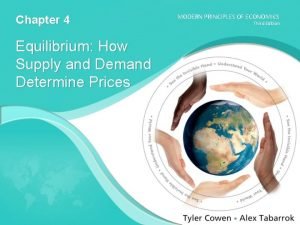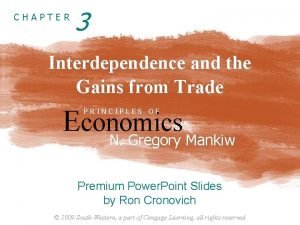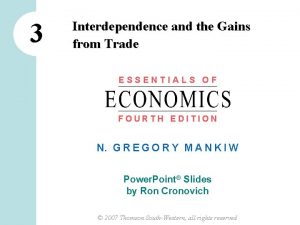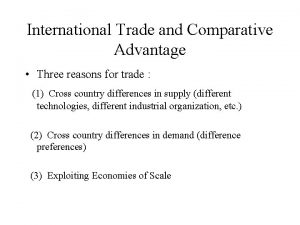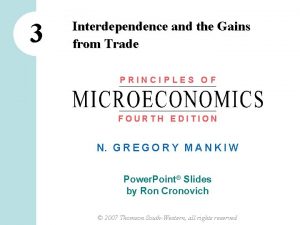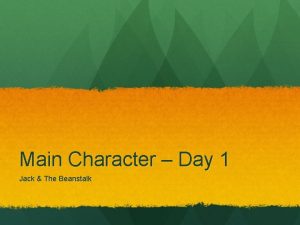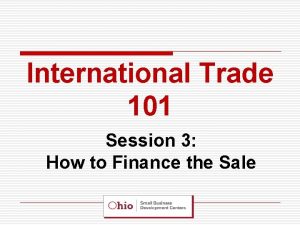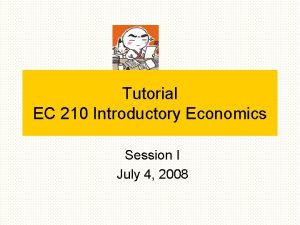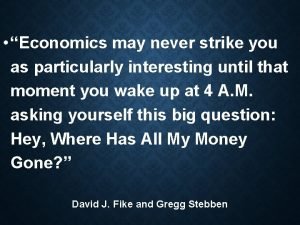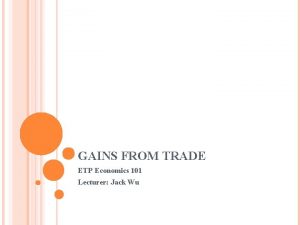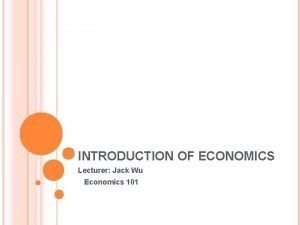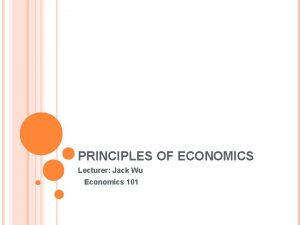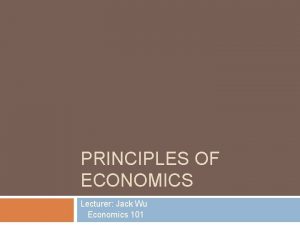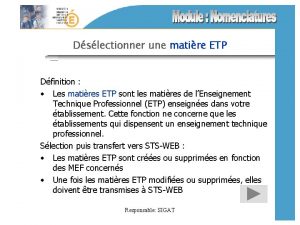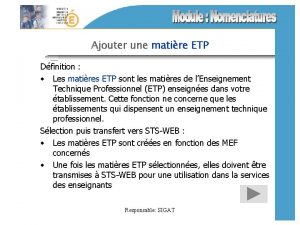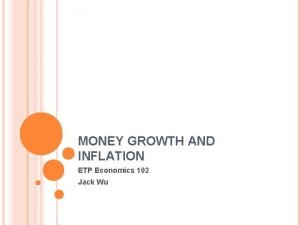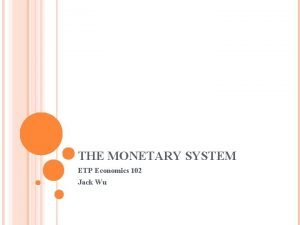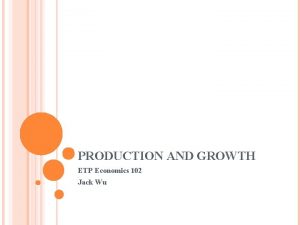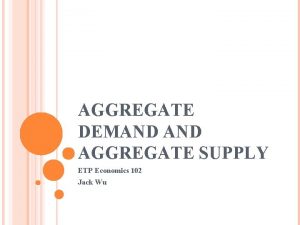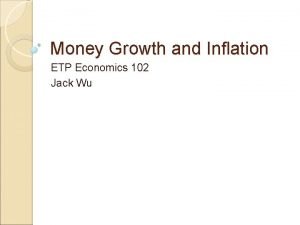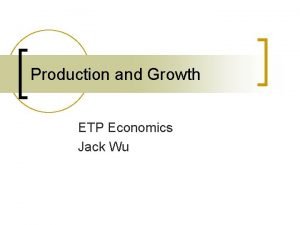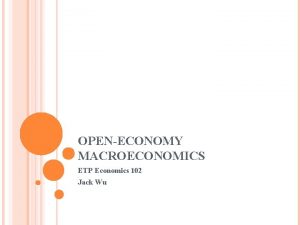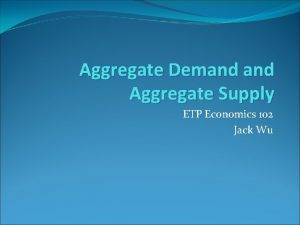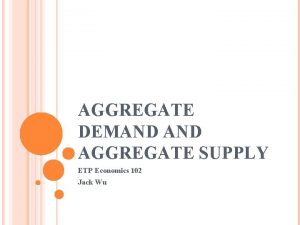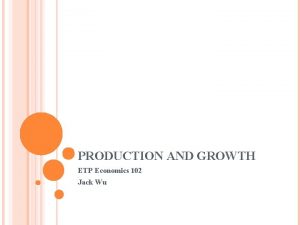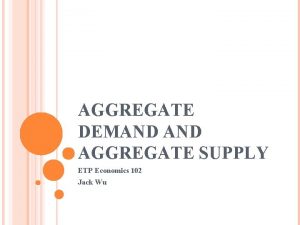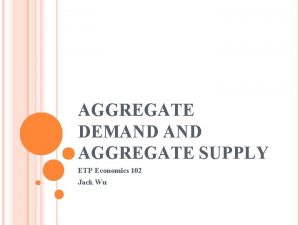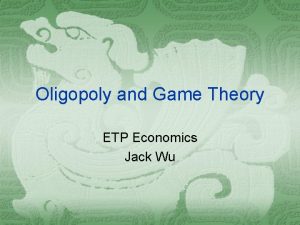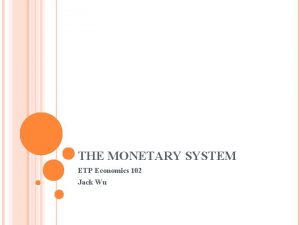GAINS FROM TRADE ETP Economics 101 Lecturer Jack

































- Slides: 33

GAINS FROM TRADE ETP Economics 101 Lecturer: Jack Wu

RECALL The production possibilities frontier is a graph that shows the combinations of output that the economy can possibly produce given the available factors of production and the available production technology.

SHAPE OF PRODUCTION POSSIBILITIES FRONTIER Concave curve (bowed outward): The opportunity cost of producing one good increases as the production of this good rises. REASON: Some resources are better suited to the production of this good than another good (and vice versa). Straight line: The opportunity cost of producing one good is constant as the production of this good rises.

NOW Let’s use the “Production Possibilities Frontier” to analyze trade problems.

AUTARKY OR TRADE? How do we satisfy our wants and needs in a global economy? We can be economically self-sufficient (Autarky). We can specialize and trade with others, leading to economic interdependence.

CASE 1 only two goods: potatoes and meat only two people: a potato farmer and a cattle rancher Each only works 8 hours/day What should each produce? Why should they trade?

CASE 1 (CONTINUED) Minutes needed to make 1 ounce of __________________ Meat Potatoes __________________ Farmer 60 min/oz 15 min/oz Rancher 20 min/oz 10 min/oz

CASE 1 (CONTINUED) Amounts produced in 8 hours __________________ Meat Potatoes __________________ Farmer 8 oz 32 oz Rancher 24 oz 48 oz

THE FARMER’S PRODUCTION POSSIBILITIES FRONTIER (a) The Farmer ’s Production Possibilities Frontier Meat (ounces) 8 0 32 Potatoes (ounces)

THE RANCHER’S PRODUCTION POSSIBILITIES FRONTIER (b) The Rancher ’s Production Possibilities Frontier Meat (ounces) 24 0 48 Potatoes (ounces)

OPPORTUNITY COST Opportunity cost Whatever must be given up to obtain some item Measures the trade-off between the two goods that each producer faces

OPPORTUNITY COSTS 1 oz of meat 1 oz of potatoes Farmer 4 oz of potatoes ¼ oz of meat Rancher 2 oz of potatoes ½ oz of meat

ABSOLUTE ADVANTAGE The comparison among producers of a good according to their productivity—absolute advantage Describes the productivity of one person, firm, or nation compared to that of another. The producer that requires a smaller quantity of inputs to produce a good is said to have an absolute advantage in producing that good.

COMPARATIVE ADVANTAGE Compares producers of a good according to their opportunity cost. Whatever must be given up to obtain some item The producer who has the smaller opportunity cost of producing a good is said to have a comparative advantage in producing that good.

APPLICATION Should Tiger Woods mow his own lawn? Woods Mow his lawn in 2 hours Film a TV commercial and earn $10, 000 (2 hours)

QUICK QUIZ 1 Who has the absolute advantage? The farmer or the rancher? Who has the comparative advantage? The farmer or the rancher?

SPECIALIZATION AND TRADE Comparative advantage and differences in opportunity costs are the basis for specialized production and trade.

QUICK QUIZ 2 What should farmer produce (or specialize in)? What should rancher produce (or specialize in)?

BENEFITS OF TRADE Whenever potential trading parties have differences in opportunity costs, they can each benefit from trade. Benefits of Trade can benefit everyone in a society because it allows people to specialize in activities in which they have a comparative advantage.

SELF-SUFFICIENCY (AUTARKY) By ignoring each other: Each consumes what they each produce. The production possibilities frontier is also the consumption possibilities frontier. Without trade, economic gains are diminished.

SELF-SUFFICIENCY (AUTARKY) Assume: Farmer spends 4 hours on meat and 4 hours on potatoes. Rancher spends 4 hours on meat and 4 hours on potatoes.

WITHOUT TRADE Production: Farmer produces 4 oz of meat and 16 oz of potatoes. Rancher produces 12 oz of meat and 24 oz of potatoes. Consumption: Farmer consumes 4 oz of meat and 16 oz of potatoes. Rancher consumes 12 oz of meat and 24 oz of potatoes.

THE FARMER’S PRODUCTION AND CONSUMPTION WITHOUT TRADE (a) The Farmer’s Production and Consumption Meat (ounces) Farmer's production and consumption without trade 8 4 A 0 32 Potatoes (ounces) 16 Copyright© 2003 Southwestern/Thomson Learning

THE RANCHER’S PRODUCTION AND CONSUMPTION WITHOUT TRADE (b) The Rancher’s Production and Consumption Meat (ounces) 24 B 12 0 24 Rancher's production and consumption without trade 48 Potatoes (ounces) Copyright © 2004 South-Western

PROPOSALS FOR SPECIALIZATION Farmer devotes all his time to growing potatoes. Rancher spends 6 hours a day raising cattle and 2 hours growing potatoes.

PRODUCTION WITH TRADE Farmer’s production with trade: 0 oz of meat and 32 oz of potatoes Rancher’s production with trade: 18 oz of meat and 12 oz of potatoes.

PROPOSAL FOR TRADE The price of trade Must lie between the two opportunity costs Trade deal: Farmer gives rancher 15 oz of potatoes, and rancher gives farmer 5 oz of meat in return. Note: Price of Meat: 2~4 oz of potatoes Note: Price of Potatoes: 1/4 oz ~1/2 oz of meat

CONSUMPTION WITH TRADE Farmer’s consumption with trade: 5 oz of meat and 17 oz of potatoes Rancher’s consumption with trade: 13 oz of meat and 27 oz of potatoes.

HOW TRADE EXPANDS THE FARMER’S SET OF CONSUMPTION OPPORTUNITIES (a) The Farmer’s Production and Consumption Meat (ounces) 8 Farmer's consumption with trade A* 5 4 Farmer's production and consumption without trade A Farmer's production with trade 0 32 16 17 Potatoes (ounces)

HOW TRADE EXPANDS THE RANCHER’S SET OF CONSUMPTION OPPORTUNITIES (b) The Rancher’s Production and Consumption Meat (ounces) Rancher's production with trade 24 Rancher's consumption with trade 18 13 B* B 12 0 12 24 27 Rancher's production and consumption without trade 48 Potatoes (ounces)

INTERNATIONAL TRADE Each country has many citizens with different interests. International trade can make some individuals worse off, even as it makes the country as a whole better off. Imports—goods produced abroad and sold domestically Exports—goods produced domestically and sold abroad

QUICK QUIZ 3 Martha and Stewart each spend 8 hours a day wallpapering and painting: Martha Stewart Hours needed to Do 1 Room Paint Wallpaper 2 hours/room 8 hours/room 4 hours/room 10 hours/room

QUICK QUIZ 4 Suppose that a worker in Cornland can grow either 40 bushels of corn or 10 bushels of oats per year, and a worker in Oatland can grow either 20 bushels of corn or 5 bushels of oats per year. There are 20 workers in Cornland 20 workers in Oatland. Which of the following statements is true? a. Both countries could gain from trade with each other. b. Neither country would gain from trade because Cornland has an absolute advantage in both goods. c. Neither country would gain from trade because neither one has a comparative advantage. d. Only Oatland could possibly gain from trade.
 Lecturer's name or lecturer name
Lecturer's name or lecturer name California etp program
California etp program Etp presentation
Etp presentation Etp pharmacy
Etp pharmacy Chapter 3 interdependence and the gains from trade summary
Chapter 3 interdependence and the gains from trade summary Interdependence and the gains from trade
Interdependence and the gains from trade Chapter 3 interdependence and the gains from trade answers
Chapter 3 interdependence and the gains from trade answers How to calculate unexploited gains from trade
How to calculate unexploited gains from trade Interdependence and the gains from trade chapter 3
Interdependence and the gains from trade chapter 3 Interdependence and the gains from trade chapter 3
Interdependence and the gains from trade chapter 3 Chapter 3 interdependence and the gains from trade
Chapter 3 interdependence and the gains from trade Law of comparative advantage
Law of comparative advantage Chapter 3 interdependence and the gains from trade summary
Chapter 3 interdependence and the gains from trade summary Main characters of jack and the beanstalk
Main characters of jack and the beanstalk Lector vs lecturer
Lector vs lecturer Lecturer in charge
Lecturer in charge Lecturer name
Lecturer name Spe distinguished lecturer
Spe distinguished lecturer Physician associate lecturer
Physician associate lecturer Lecturer in charge
Lecturer in charge Designation lecturer
Designation lecturer Pearson lecturer resources
Pearson lecturer resources Good morning teacher good morning teacher
Good morning teacher good morning teacher Cfa lecturer handbook
Cfa lecturer handbook Designation of lecturer
Designation of lecturer Spe distinguished lecturer
Spe distinguished lecturer Photography lecturer
Photography lecturer Lecturer asad ali
Lecturer asad ali Gcwak
Gcwak Trade finance 101
Trade finance 101 Economics and business economics maastricht
Economics and business economics maastricht Non mathematical economics
Non mathematical economics Trade off definition economics
Trade off definition economics What is trade off in economics
What is trade off in economics

